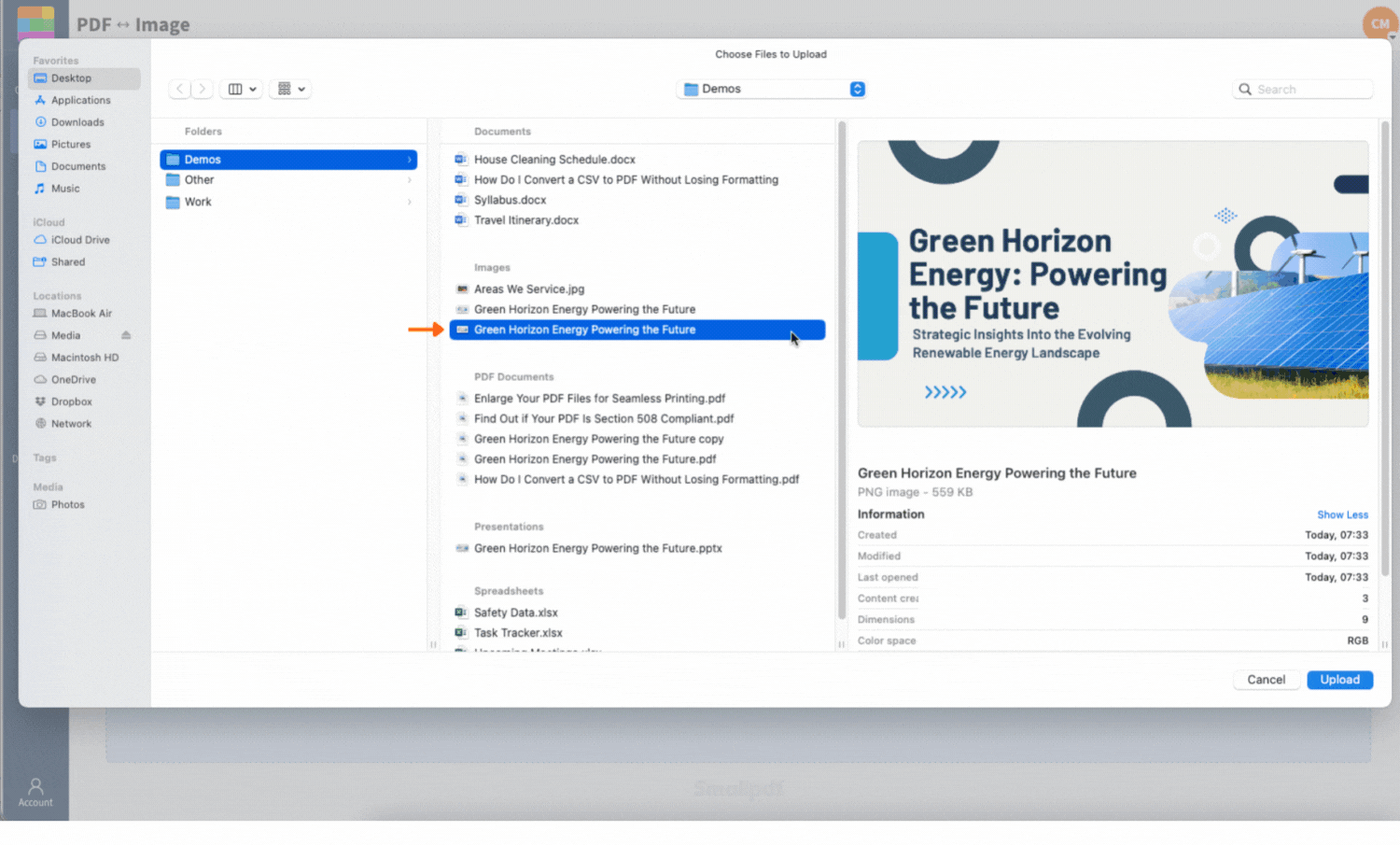
Convert image files to JPG online in seconds, for free—no installs, no sign-up, no stress. We support PNG, BMP, GIF, WebP, HEIC, and TIFF.
How to Convert Images to JPG Online (Step-by-Step)
Even if you have never converted an image before, there's no need to stress. As an online JPG converter, Smallpdf works straight from your browser, no software or account needed.
1. Open the Image to JPG Tool
Navigate to the Image to JPG tool in your browser.
2. Upload Your Image(s)
Drag your image into the toolbox or click to browse files.
3. Convert to JPG
Wait a moment while the tool converts your image to a PDF behind the scenes.
4. Export and Download
Click “Export As” and “select Image (.jpg).” Choose “Extract images only.” Click “Download” to save your new JPG file.
5. Save to Cloud (Optional)
You can also save directly to Google Drive, OneDrive, or Dropbox if you work in the cloud.

Our image to JPG free tool supports everyday formats and lets you convert up to two images daily.
When to Convert to JPG: Common Uses and Benefits
There are hundreds of image file formats out there. Some were created for specific software, others for high-res printing, and a few designed for modern phones or web use.
But not all of them play nicely with every device or app.
JPG is one of the most widely supported and reliable image formats. It works just about everywhere, from email and messaging apps to websites and Microsoft Office documents. It also compresses image data, which keeps file sizes small without totally tanking the quality. So when you're sharing a screenshot, printing a photo, or if you need to convert a PNG to JPG before adding an image to a document or compressing the file, this tool does it instantly.
It's also ideal for archiving and organizing your files. JPGs take up less space, load faster on mobile, and work better in low-bandwidth environments. Think digital portfolios or uploading product shots to your website.
- Web optimization: Smaller file sizes mean faster page load speeds.
- Email attachments: JPGs are universally supported and compress well.
- Social media posting: Most platforms prefer JPG for photos.
- Document compatibility: Works seamlessly in Word, PowerPoint, and other office apps.
Supported Image Formats You Can Convert to JPG
Smallpdf supports a wide range of formats, making it easy to convert almost any image to JPG. That includes popular types like PNG, BMP, GIF, WebP, TIFF, and HEIC. Our image file converter makes it easy to turn almost anything into a clean, shareable JPG.
One thing you need to remember is that if you upload an animated GIF, the JPG output will be a static image. JPG doesn't support animation, so you'll get the first frame only.
Convert Multiple Images to JPG at Once (Batch Options)
Yes, but it depends on your plan. Free users can convert up to two files per day using any of Smallpdf's tools. If you need to convert a batch of images, there's a neat workaround: use Merge PDF to combine several images into one PDF. Then, export that file as JPG and you'll get one image per page.
With a Pro plan, there's no daily limit, so you can convert as many images as you like, whenever you like. If you're working on design projects, product catalogues, or processing document scans in bulk, sign up for a free 7-day trial before you commit.
Free and Secure JPG Converter Online
Our browser-based converter means no software downloads or installations required. You don't even need to sign up for an account to get started. Here's what makes our online JPG converter secure and reliable:
- No installation required: Works directly in your browser.
- Automatic file deletion: Your files are removed from our servers after processing.
- SSL encryption: All uploads and downloads are protected with 256-bit encryption.
- Privacy controls: No signup means no tracking or data collection.
Keep Image Quality When You Convert to JPG (and Reduce File Size)
JPG is a compressed format, which means it can lose a bit of image detail in the process. But there are a few things you can do to keep your converted files looking sharp:
- Use high-quality originals. Starting with a clean, clear image gives you the best result.
- Avoid re-converting compressed images. Each conversion can reduce quality, especially for things like logos or line drawings.
- Resize before converting if you're aiming for a specific image size. It's easier to control resolution this way than trying to resize later.
Save and Share Your JPGs Anywhere (Drive, Dropbox, OneDrive)
Once your image is converted, you have multiple options for saving and sharing. Other than downloading to your device, you can save directly to your favorite cloud storage service. This makes it easy to access your converted JPGs from any device or share them with colleagues instantly.
Our cloud integrations include Google Drive, OneDrive, and Dropbox, so your converted files can live wherever your workflow needs them.
More PDF and Image Tools from Smallpdf
Start your free trial to access all Smallpdf tools.
You aren't limited to JPG conversion. With Smallpdf, you can work across browsers and mobile, store files in the cloud, and access more than 30 PDF tools.
Our platform lets you convert files between Word, Excel, PowerPoint, and PDF formats too, so your entire digital workflow can live in one place. Use tools like Compress PDF to reduce large scans, or PDF Annotator to add text or comments to visuals after converting.
Our iOS and Android apps are also ready when you are, even when on the move. And with handy cloud connections, cloud storage through Google Drive, OneDrive, and Dropbox makes life easier if you're juggling files across platforms.
FAQs: Converting Images to JPG
What's the difference between JPG and JPEG?
They're actually the same format. “JPG” is just a shortened version of “JPEG,” created to fit older Windows naming restrictions. Today, both extensions are used interchangeably, and if you convert an image to JPEG, you won't run into compatibility issues.
Does converting to JPG reduce quality?
Possibly. JPG uses lossy compression, which means some image data gets discarded to reduce file size. For casual use, this usually isn't noticeable.
Can I convert HEIC or WebP to JPG?
Yes! These newer formats are fully supported. Just drop your file into the tool and we'll do the rest.
How do I convert images to JPG on iPhone or Android?
Simply drop your files into the tool using your mobile browser, or download our iOS and Android apps for on-the-go conversion.
Can I convert multiple images to JPG at once?
Free users can convert up to two files daily. Pro users have unlimited batch conversion capabilities.
Is Smallpdf's JPG converter secure?
Yes, we use 256-bit SSL encryption and automatically delete files an hour after processing to protect your privacy.



